 Research Article
Research Article
Dentist’s Knowledge, Attitude, and Practice Regarding Deep Margin Elevation
Naima Ayari1*, Sarra Nasri2, Anissa Ben Moussa3, Dalenda Hadyaoui4, Zohra Nouira4, Belhassen Harzallah4 and Mounir Cherif4
1Resident, Department of Dental Medicine, Sahloul Hospital, Department of Fixed Prosthodontics, Dental Faculty of Monastir, University of Monastir, Tunisia
2Assistante Professor, Department of Fixed Prosthodontics, Faculty of Dental Medicine, Monastir, Tunisia
3Associate Professor, Department of Fixed Prosthodontics, Faculty of Dental Medicine, University of Monastir, Tunisia
4Professor, Department of Fixed Prosthodontics, Faculty of Dental Medicine, University of Monastir, Tunisia
Naima Ayari, Resident, Department of Dental Medicine, Sahloul Hospital, Department of Fixed Prosthodontics, Dental Faculty of Monastir, University of Monastir, Tunisia.
Received Date: April 20, 2023; Published Date: April 27, 2023
Abstract
Objective: This study aimed to assess the level of knowledge, attitude, and practice toward deep margin elevation for managing deep proximal caries among dental Tunisian practitioners.
Methods: A questionnaire-based study was carried out during January-March 2023.. The questionnaire, comprising a total of 19 questions, was divided into three main categories, and was administered to dental professionals through google forms.
Results: A total of 120 dental practitioners participated in this study. Only, a third of them have utilized deep margin elevation technique in their dental practitioners. It can be concluded that most practitioners were aware of the minimally invasive dentistry.
Conclusion: Deep margin elevation seems to be a valuable and a reasonable treatment option, aiming to avoid surgical crown lengthening and orthodontic extrusion in the case of deep margins extending below the cementoenamel junction. However, more studies and randomized controlled clinical trials are necessary to support the use of use of this technique.
Keywords:Deep margin elevation; Subgingival; Indirect restoration; Dentin bonding; Marginal adaptation; Fracture resistance; Biological width
Abbreviations:DME: Deep Margin Elevation; CMR: Coronal Margin Relocation; OE: Orthodontic extrusion; GIC: Glass Ionomer Cement; RMGIC: Resin Modified Ionomer Cement; HRC: Hybrid resin composite; FC: Flowable composite; BFC: Bulk fill composite
Introduction
Nowadays, patients avoid amalgam restorations and metal crowns for posterior teeth because of their unappealing appearance. This resulted in a growing demand for esthetic restorations [1]. In the past two decades, materials and adhesive techniques have become the object of interest for research subjects because of the increase of the esthetic requests. Unfortunately, new problems have appeared especially in large posterior defects located beneath the gingival tissues. In fact, the use of direct aesthetic restorations in such situations, increases the risk of polymerization shrinkage and may cause problems such as fractures and microleakage. These complications may lead to postoperative sensitivity, marginal staining, and secondary caries.
However, the use of indirect restorations with deep margins extending below the cemento-enamel junction is much disputed. Two major clinical problems may occur: the possible violation of the biological width and technical-operative problems during cavity preparation, isolation of the operatory field, impression taking, and adhesive cementation. Surgical margin relocation can overcome this, but it is associated with attachment loss and anatomic complications because of the proximity to root concavities and the furcation area [2]. In 1998 Dietschi and Spreafico presented the technique of deep margin elevation as an alternative [3]. This technique proposed the application of composite resin in the most profound parts of the proximal areas in order to reposition the cervical margin supragingivally [4]. Therefore, the purpose of this study was to assess the level of knowledge, practice and attitude towards deep margin elevation in the management of deep proximal caries among Tunisian dental practitioners.
Materials and Methods
The present cross-sectional questionnaire-based study was carried out during January-March 2023. The questionnaire was administered to dental professionals through google forms, an internet-based software commonly used for data collection via personalized surveys and was administered through social media platforms. A pilot study was conducted among a small group of clinical dentists to test the validity and quality of the questions. The questionnaire items were then analyzed to evaluate the level of difficulty in understanding, interpreting, and answering correctly. A convenient sampling technique was utilized for the selection of dentists.
Anonymity was maintained: The participants were informed that the information provided by them would be confidential with only the principal investigator having access to the data. The questionnaire, comprising a total of 19 questions, was divided into three main categories: Demographic details in the first section which included sex, age, qualification, health sector and years of experience.
The second section was made up of 11 questions which focused on knowledge, attitude and practice of dental practitioners on DME. The third section included some clinical situations. The study population involved general dentists and specialists either working in a private or government sector.
Inclusion criteria: These included dental practitioners, males and females, working in Tunisia, with at least one year of experience. They also included general dentists and specialists working either in the private or government sector.
Exclusion criteria: students of dental medicine (from the first to the 5th year), interns and dental practitioners who were not working in Tunisia and with experience less than one year were excluded from the study.
Statistical Package for the Social Sciences (SPSS) software, version 21, was used in the analysis of data. A descriptive analysis was carried out to establish a general understanding of the study population. Categorical variables were reported in frequencies and percentages.
Results
The results revealed that a total of 120 dental practitioners participated in the study: 52.3% were males and 47.7% were females (Figure 1).
About 47.9% were general dentists and 43.7% were specialists.
Most of the respondents worked in a medical center (42.9%), followed by private sectors (37.8%) and only 19.3% worked in the government sector (Figure 2).
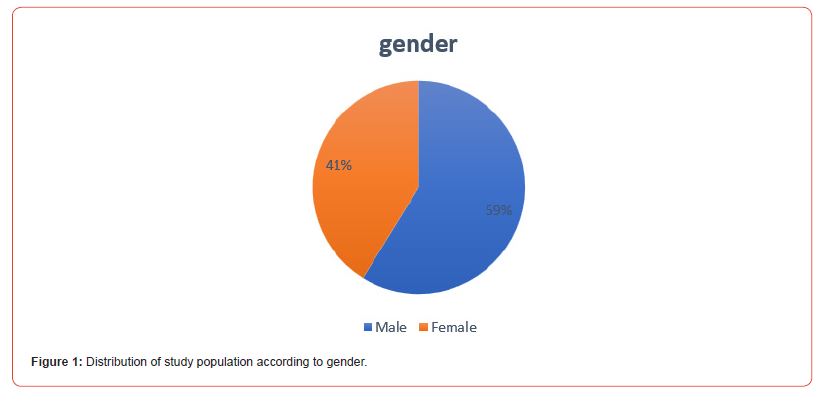

A total of 57.1% had less than five years of experience, while 21.8% had 5 to 10 years and the rest had more than 10 years (Figure 3).
It was found that many practitioners were aware of the minimally invasive dentistry. Indeed, 55.5% indicated a full crown when restoring a wide occluso-proximal cavity extending below the cemento-enamel junction and only 26.9% indicated an adhesive restoration (Figure 4).
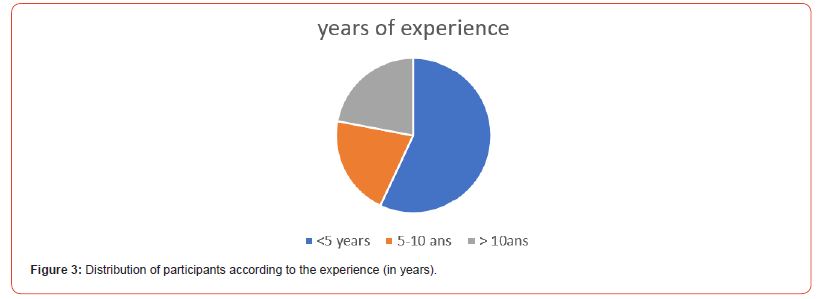
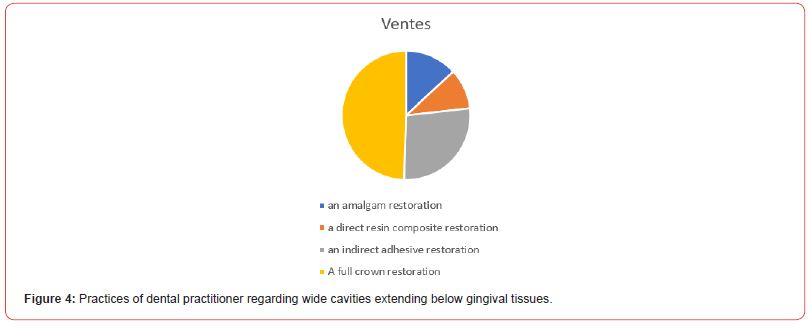
Furthermore, 37.8% believed that the deep margin elevation was the optimal choice to deal with subgingival margins for indirect bonded restorations (Figure 5).
As regards biological width, 73.9% agreed that the biological width was a factor that should be known before any procedure and that the non-invasion of the epithelial and connective tissues was possible.
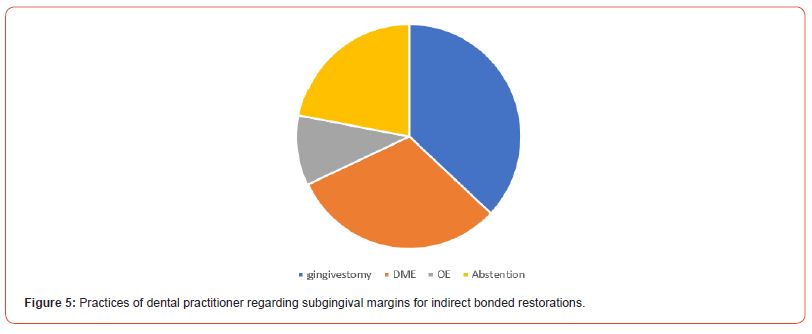
The results also showed that the majority of respondents recommended the resin-modified glass ionomer cement as the optimal material to elevate the margin in such fluid environment.
As regards the attitude towards the durability of adhesive restorations, 50% and 45% of the respondents agreed that there was no difference, respectively, in the marginal adaptation and in the prevalence of secondary caries of the restoration placed directly on subgingival margins or indirectly on the filling material. Moreover, 58% agreed that fracture resistance of indirect restoration was better with deep margin elevation (Figure 7).
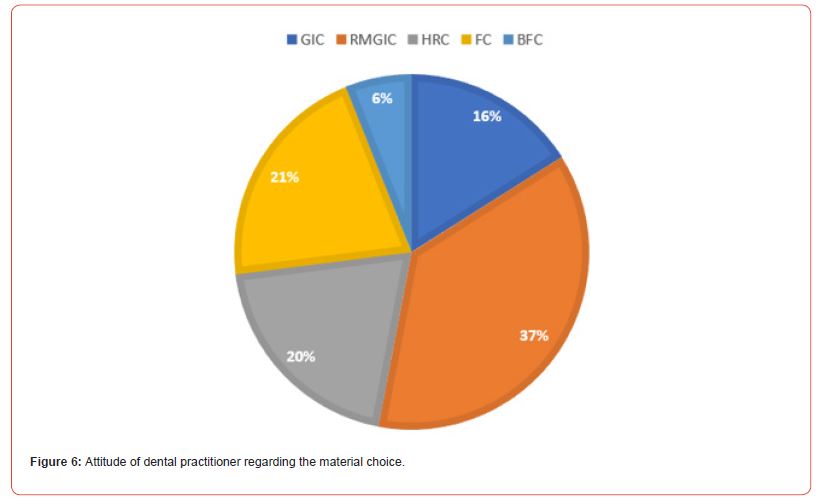
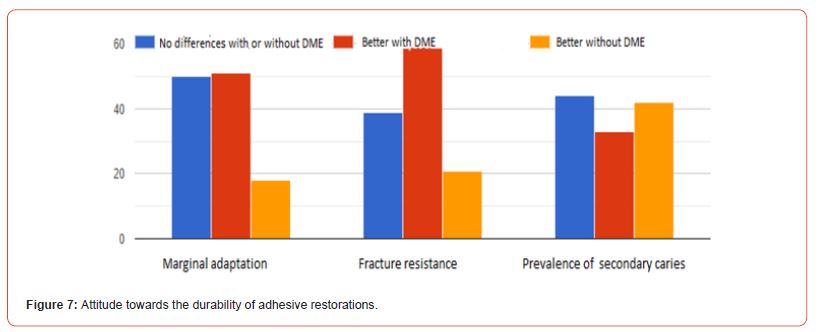
Discussion
Dental treatment in today’s modern society is shifting towards a more esthetic and conservative approach due to the public’s demand and desire. Although there has been a paradigm shift in restorative dentistry, dental practitioners are still being challenged in restoring deep subgingival carious lesions. This study evaluated the practitioners’ knowledge, practice and attitude towards DME. Based on the results of this study, a third of the respondents have used this technique in their dental practice. This percentage highlights the fact that proximal box elevation technique is a new approach for deep cavities that was described 20 years ago. It seems to be a valuable and a reasonable treatment option aiming to avoid surgical crown lengthening and orthodontic extrusion when it is possible. The aim of this technique is to simplify the procedures of taking impressions, perfecting an emergency profile, isolation, and removal of excess bonding agent [5].
Nowadays, this procedure has become most widely used and supported by subsequent publications arguing in favor of its safety and efficiency from a clinical, biological and mechanical viewpoint. In 2019, Bresser, et al. [6] published the first retrospective study about this procedure. This long-term study confirmed the clinical applicability of deep margin elevation with a good survival rate. In fact, eight absolute failures in 197 partial indirect restorations were observed against an overall survival rate of approximately 96% for up to 12 years. Regarding the most appropriate material to be used, the choice between glass ionomer cement, highly filled hybrid or fluid composites is still debated today. In fact, resin modified glass ionomers are not recommended due to their inferior mechanical properties and high solubility rates.
Therefore, flowable and viscous restorative composites could be selected for CMR technique. A careful study of the literature revealed that classical restorative hybrid composites provide better mechanical properties and lower polymerization shrinkage, but lower viscosity. So, when micro- hybrid or nano-hybrid composite materials are used, the matrix can be displaced during the placement of these firm materials. It is recommended to warm up the material in order to simplify the placement and reduce the risk of interlayer gaps [7].
Additionally, another approach suggested the use of bulk fill fluid materials and silorane composites. Regarding adhesive system, a 3-step total-etch adhesive or a 2-step self-etch adhesive system can be applied. The findings of this study revealed that 73.9% agreed that biological width was a factor that should be known before any procedure to avoid inflammation of the periodontium which may lead to gingivitis or periodontitis. Indeed, through their study Martins, et al. [8] demonstrated the binding capacity of the fibers of epithelial tissue to the surface of resin restorations, provided that the hygiene conditions were optimum [8]. So, this procedure does not affect the periodontal status of patients when the connective department was not violated.
The presence of a composite liner underneath ceramic CAD/ CAM restorations following different surface treatments did not affect restoration marginal or internal adaptation. From a biomechanical point of view, proximal box elevation does not affect the fracture strength of indirect restorations [9]. In the presented clinical situation of this study, most respondents selected the most conservative treatment modality in treating proximal boxes in posterior teeth that are located below the gingival level.
The knowledge level of DME among the respondents of this study was adequate. The results of this study revealed that a few dentists had utilized the technique in restoring large subgingival defects of posterior teeth with proximal caries. This may be explained by the recentness of this technique. Thus, it is recommended that dental practitioners have this technique introduced in their dental clinics as an alternative to surgical crown lengthening. Although years of experience may influence the clinical decision, in‑depth factorial analysis with a greater sample size is necessary. Regarding its multiple advantages, we aimed through this study to introduce this technique to a number of dentists ignoring it and to encourage them to apply it in their practice. Further studies need to be conducted in order to encourage the use of this technique in clinical practice.
Conclusion
The knowledge level of DME among the respondents of this study was adequate. The results of this study revealed that a few dentists had utilized the technique in restoring large subgingival defects of posterior teeth with proximal caries. This may be explained by the recentness of this technique. Thus, it is recommended that dental practitioners have this technique introduced in their dental clinics as an alternative to surgical crown lengthening. Although years of experience may influence the clinical decision, in‑depth factorial analysis with a greater sample size is necessary. Regarding its multiple advantages, we aimed through this study to introduce this technique to a number of dentists ignoring it and to encourage them to apply it in their practice. Further studies need to be conducted in order to encourage the use of this technique in clinical practice.
Acknowledgement
None.
Conflict of Interest
No conflict of interest.
References
- Abduo J, Sambrook RJ (2018) Longevity of ceramic onlays: A systematic review. J Esthet Restor Dent 30(3): 193-215.
- Köken S, Juloski J, Sorrentino R, Grandini S, Ferrari M (2018) Marginal sealing of relocated cervical margins of mesio-occluso-distal overlays. J Oral Sci 60(3): 460-468.
- Dietschi D, Spreafico R (1998) Current clinical concepts for adhesive cementation of tooth-colored posterior restorations. Pract Periodontics Aesthet Dent 10: 47-54.
- Juloski J, Köken S, Ferrari M (2018) Cervical margin relocation in indirect adhesive restorations: A literature review. J Prosthodont Res 62(3): 273-280.
- Dablanca Blanco AB, Blanco Carrión J, Martín Biedma B, Varela Patiño P, Bello Castro A, et al. (2017) Management of large class II lesions in molars: how to restore and when to perform surgical crown lengthening?. Restor Dent Endod 42(3): 240-252.
- Bresser RA, Gerdolle D, Van den Heijkant IA, Sluiter Pouwels LMA, Cune MS, et al. (2019) Up to 12 years clinical evaluation of 197 partial indirect restorations with deep margin elevation in the posterior region. J Dent 91: 103227.
- Fróes Salgado NR, Silva LM, Kawano Y, Francci C, Reis A, et al. (2010) Composite pre-heating: effects on marginal adaptation, degree of conversion and mechanical properties. Composite pre-heating: effects on marginal adaptation, degree of conversion and mechanical properties 26(9): 908-914.
- Martins TM, Bosco AF, Nobrega FJ, Nagata MJ, Garcia VG, et al. (2007) Periodontal tissue response to coverage of root cavities restored with resin materials: a histomorphometric study in dogs. J Periodontol 78(6): 1075-1082.
- Ilgenstein I, Zitzmann NU, Bühler J, Wegehaupt FJ, Attin T, et al. (2015) Influence of proximal box elevation on the marginal quality and fracture behavior of root-filled molars restored with CAD/CAM ceramic or composite onlays. Clin Oral Investig 19: 1021-1028.
-
Naima Ayari*, Sarra Nasri, Anissa Ben Moussa, Dalenda Hadyaoui, Zohra Nouira, Belhassen Harzallah and Mounir Cherif. Dentist’s Knowledge, Attitude, and Practice Regarding Deep Margin Elevation. On J Dent & Oral Health. 7(1): 2023. OJDOH. MS.ID.000653.
-
Dental practitioners, Minimally invasive dentistry, Gingival tissues, Posterior teeth, Dental practice, Proximal caries, Dental clinics, Dentists, Periodontal status, Resin restorations.
-

This work is licensed under a Creative Commons Attribution-NonCommercial 4.0 International License.






